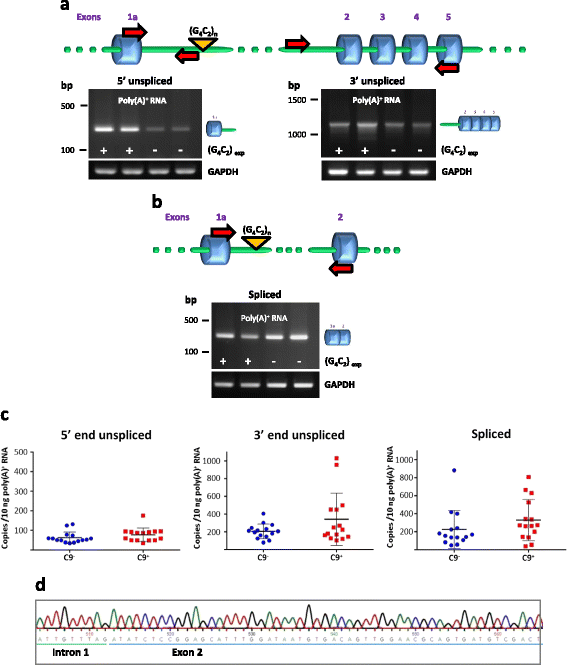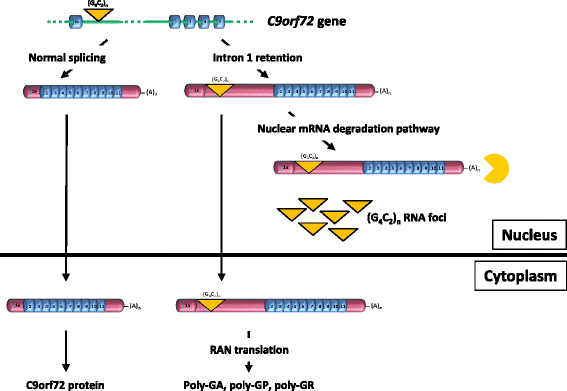Retention of hexanucleotide repeat-containing intron in C9orf72 mRNA: implications for the pathogenesis of ALS/FTD
- PMID: 26916632
- PMCID: PMC4766718
- DOI: 10.1186/s40478-016-0289-4
Retention of hexanucleotide repeat-containing intron in C9orf72 mRNA: implications for the pathogenesis of ALS/FTD
Abstract
Introduction: The most common forms of amyotrophic lateral sclerosis and frontotemporal dementia are caused by a large GGGGCC repeat expansion in the first intron of the C9orf72 gene. The repeat-containing intron should be degraded after being spliced out, however GGGGCC repeat-containing RNA species either accumulate in nuclear foci or are exported to the cytoplasm where they are translated into potentially toxic dipeptide repeat proteins by repeat-associated non-AUG-initiated (RAN) translation.
Results: In order to determine the mechanisms of repeat-containing intron misprocessing, we have analyzed C9orf72 transcripts in lymphoblasts from C9orf72 expansion carriers (n = 15) and control individuals (n = 15). We have identified polyadenylated C9orf72 RNA species retaining the repeat-containing intron and in which downstream exons are spliced correctly resulting in a C9orf72 mRNA with an enlarged 5'-UTR containing the GGGGCC repeats. Intron-retaining transcripts are produced from both wild-type and mutant alleles. Intron-retaining C9orf72 transcripts were also detected in brain with a 2.7 fold increase measured in the frontal cortex from heterozygous expansion carriers (n = 11) compared to controls (n = 10). The level of intron-retaining transcripts was increased 5.9 fold in a case homozygous for the expansion. We also show that a large proportion of intron 1-retaining C9orf72 transcripts accumulate in the nucleus.
Conclusions: Retention of the repeat-containing intron in mature C9orf72 mRNA can potentially explain nuclear foci formation as well as nuclear export of GGGGCC repeat RNA and suggests that the misprocessing of C9orf72 transcripts initiates the pathogenic process caused by C9orf72 hexanucleotide repeat expansions as well as provides the basis for novel therapeutic strategies.
Figures





Similar articles
-
Cryptic intronic transcriptional initiation generates efficient endogenous mRNA templates for C9orf72-associated RAN translation.Proc Natl Acad Sci U S A. 2025 Aug 12;122(32):e2507334122. doi: 10.1073/pnas.2507334122. Epub 2025 Aug 4. Proc Natl Acad Sci U S A. 2025. PMID: 40758885
-
Human C9ORF72 Hexanucleotide Expansion Reproduces RNA Foci and Dipeptide Repeat Proteins but Not Neurodegeneration in BAC Transgenic Mice.Neuron. 2015 Dec 2;88(5):902-909. doi: 10.1016/j.neuron.2015.11.018. Neuron. 2015. PMID: 26637797 Free PMC article.
-
Nuclear export and translation of circular repeat-containing intronic RNA in C9ORF72-ALS/FTD.Nat Commun. 2021 Aug 13;12(1):4908. doi: 10.1038/s41467-021-25082-9. Nat Commun. 2021. PMID: 34389711 Free PMC article.
-
Pathogenic determinants and mechanisms of ALS/FTD linked to hexanucleotide repeat expansions in the C9orf72 gene.Neurosci Lett. 2017 Jan 1;636:16-26. doi: 10.1016/j.neulet.2016.09.007. Epub 2016 Sep 13. Neurosci Lett. 2017. PMID: 27619540 Free PMC article. Review.
-
C9orf72 ALS-FTD: recent evidence for dysregulation of the autophagy-lysosome pathway at multiple levels.Autophagy. 2021 Nov;17(11):3306-3322. doi: 10.1080/15548627.2021.1872189. Epub 2021 Feb 26. Autophagy. 2021. PMID: 33632058 Free PMC article. Review.
Cited by
-
C9orf72 is differentially expressed in the central nervous system and myeloid cells and consistently reduced in C9orf72, MAPT and GRN mutation carriers.Acta Neuropathol Commun. 2016 Apr 14;4(1):37. doi: 10.1186/s40478-016-0306-7. Acta Neuropathol Commun. 2016. PMID: 27079381 Free PMC article.
-
C9orf72 repeat expansion creates the unstable folate-sensitive fragile site FRA9A.NAR Mol Med. 2024 Nov 12;1(4):ugae019. doi: 10.1093/narmme/ugae019. eCollection 2024 Oct. NAR Mol Med. 2024. PMID: 39669124 Free PMC article.
-
TCF4-mediated Fuchs endothelial corneal dystrophy: Insights into a common trinucleotide repeat-associated disease.Prog Retin Eye Res. 2021 Mar;81:100883. doi: 10.1016/j.preteyeres.2020.100883. Epub 2020 Jul 28. Prog Retin Eye Res. 2021. PMID: 32735996 Free PMC article. Review.
-
Aberrant splicing exonizes C9orf72 repeat expansion in ALS/FTD.Nat Neurosci. 2025 Aug 11. doi: 10.1038/s41593-025-02039-5. Online ahead of print. Nat Neurosci. 2025. PMID: 40790269
-
The Spectrum of Neurological and White Matter Changes and Premutation Status Categories of Older Male Carriers of the FMR1 Alleles Are Linked to Genetic (CGG and FMR1 mRNA) and Cellular Stress (AMPK) Markers.Front Genet. 2018 Nov 12;9:531. doi: 10.3389/fgene.2018.00531. eCollection 2018. Front Genet. 2018. PMID: 30483310 Free PMC article.
References
Publication types
MeSH terms
Substances
Grants and funding
- GALLO/APR14/827-791/MNDA_/Motor Neurone Disease Association/United Kingdom
- 089701/WT_/Wellcome Trust/United Kingdom
- SHAW/APR15/970-797/MNDA_/Motor Neurone Disease Association/United Kingdom
- G1100695/MRC_/Medical Research Council/United Kingdom
- MR/L016397/1/MRC_/Medical Research Council/United Kingdom
LinkOut - more resources
Full Text Sources
Other Literature Sources
Medical
Miscellaneous

